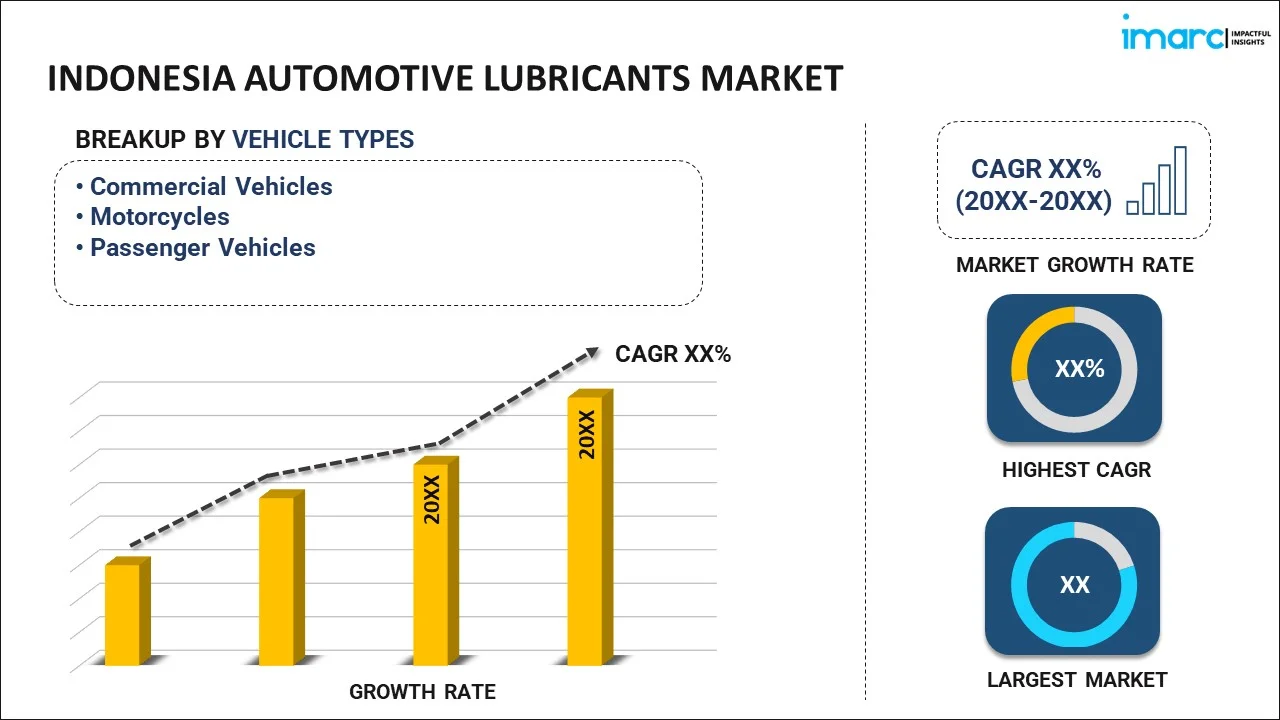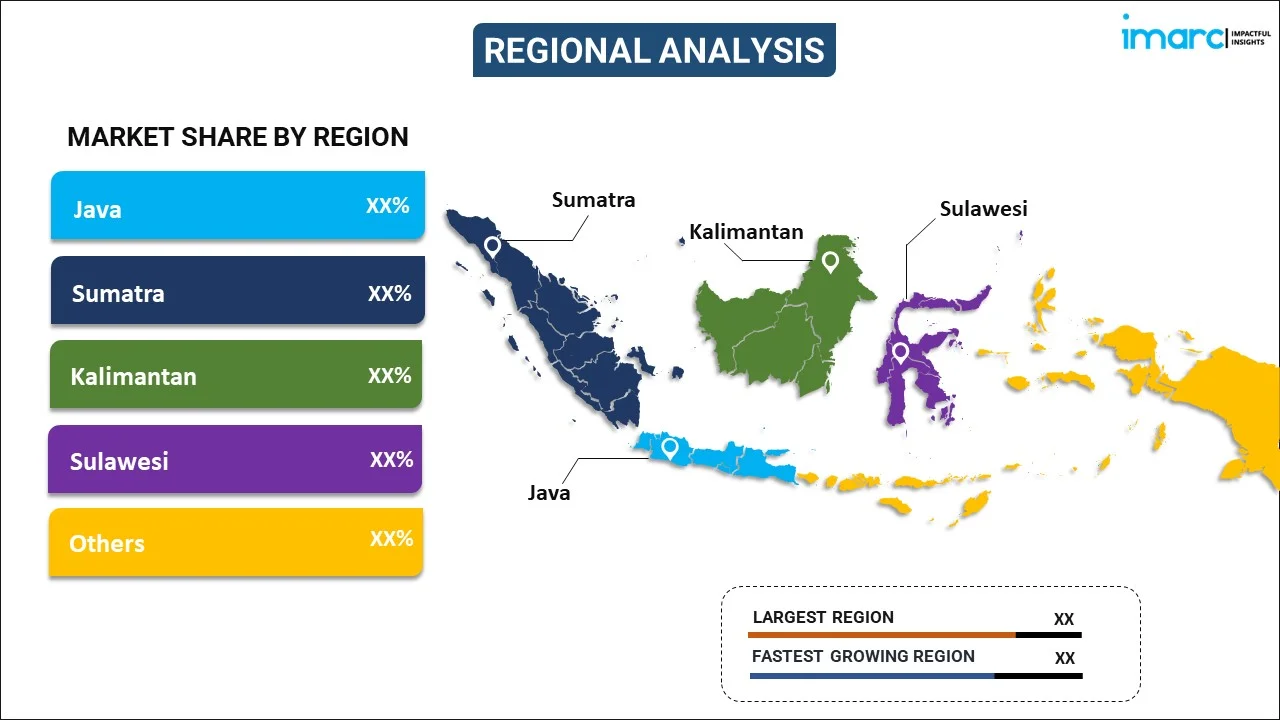
Indonesia Automotive Lubricants Market Report by Vehicle Type (Commercial Vehicles, Motorcycles, Passenger Vehicles), Product Type (Engine Oils, Greases, Hydraulic Fluids, Transmission and Gear Oils), and Region 2024-2032
Market Overview:
The Indonesia automotive lubricants market size is projected to exhibit a growth rate (CAGR) of 4.95% during 2024-2032. The burgeoning automotive industry in the country, rising disposable income of consumers, growing development of roads, implementation of favorable governmental policies, increasing focus on environmental conservation, and the adoption of electric and hybrid vehicles represent some of the key factors driving the market.
|
Report Attribute
|
Key Statistics
|
|---|---|
|
Base Year
|
2023 |
|
Forecast Years
|
2024-2032 |
|
Historical Years
|
2018-2023
|
| Market Growth Rate (2024-2032) | 4.95% |
Automotive lubricants refer to substances that reduce friction between moving parts within a vehicle’s engine, gearbox, and other components. They serve to dissipate heat, protect against wear and tear, and improve the longevity of automotive parts. Automotive lubricants are available in various types, such as engine oils, gear oils, brake fluids, greases, and transmission fluids. They are produced using mineral oils, synthetic oils, and additives like anti-wear agents, detergents, and viscosity modifiers. Automotive lubricants are widely used in engines, transmission systems, brake systems, power steering, suspension systems, electrical systems, air conditioning units, and ancillary functions like rust prevention. They aid in enhancing vehicle performance, reducing maintenance costs, improving fuel efficiency, protecting against rust and corrosion, dissipating heat, minimizing engine noise, and augmenting cold-start performance. Moreover, automotive lubricants offer various advantages, such as prolonged engine life, better resale value for the vehicle, reduced greenhouse gas emissions, excellent operational efficiency under extreme conditions, and overall improvement in vehicle reliability.
Indonesia Automotive Lubricants Market Trends:
The burgeoning automotive industry in the country and the increasing vehicle ownership are major factors contributing to the market growth. In addition to this, the rising disposable income of consumers, stimulating the purchase of new and used vehicles, is positively influencing the market growth. Furthermore, the growing development of roads, paving the way for heightened vehicle usage and regular application of high-quality lubricants, is creating a positive outlook for the market. Besides this, the implementation of favorable governmental policies and the increasing focus on environmental conservation, promoting the adoption of advanced, eco-friendly lubricants, is bolstering the market growth. In addition to this, rapid technological advancements, such as the development of synthetic lubricants with long-lasting performance, better viscosity, and higher temperature resistance are positively impacting the market growth. Moreover, the increasing adoption of electric and hybrid vehicles, facilitating the need for specialized lubricants, is providing a thrust to the market growth. Along with this, the rising shift in automotive maintenance towards longer service intervals, promoting the availability of lubricants with extended service lives, is anticipated to drive the market growth. In line with this, the changing consumer preferences for products offering convenience and reduced maintenance costs are stimulating the market growth. Apart from this, the increasing online retail of automotive lubricants, making it easier for consumers to make informed decisions based on a wide array of options and detailed product information, is propelling the market growth. Furthermore, the rising entrance of global players into the Indonesian market, prompting local manufacturers to elevate their standards, innovate, and expand their product lines, is acting as a growth-inducing factor.
Indonesia Automotive Lubricants Market Segmentation:
IMARC Group provides an analysis of the key trends in each segment of the market, along with forecasts at the country level for 2024-2032. Our report has categorized the market based on vehicle type and product type.
Vehicle Type Insights:

- Commercial Vehicles
- Motorcycles
- Passenger Vehicles
The report has provided a detailed breakup and analysis of the market based on the vehicle type. This includes commercial vehicles, motorcycles, and passenger vehicles.
Product Type Insights:
- Engine Oils
- Greases
- Hydraulic Fluids
- Transmission and Gear Oils
A detailed breakup and analysis of the market based on the product type have also been provided in the report. This includes engine oils, greases, hydraulic fluids, and transmission and gear oils.
Regional Insights:

- Java
- Sumatra
- Kalimantan
- Sulawesi
- Others
The report has also provided a comprehensive analysis of all the major regional markets, which include Java, Sumatra, Kalimantan, Sulawesi, and others.
Competitive Landscape:
The market research report has also provided a comprehensive analysis of the competitive landscape in the market. Competitive analysis such as market structure, key player positioning, top winning strategies, competitive dashboard, and company evaluation quadrant has been covered in the report. Also, detailed profiles of all major companies have been provided.
Indonesia Automotive Lubricants Market Report Coverage:
| Report Features | Details |
|---|---|
| Base Year of the Analysis | 2023 |
| Historical Period | 2018-2023 |
| Forecast Period | 2024-2032 |
| Units | Million Liters |
| Scope of the Report | Exploration of Historical Trends and Market Outlook, Industry Catalysts and Challenges, Segment-Wise Historical and Future Market Assessment:
|
| Vehicle Types Covered | Commercial Vehicles, Motorcycles, Passenger Vehicles |
| Product Types Covered | Engine Oils, Greases, Hydraulic Fluids, Transmission and Gear Oils |
| Regions Covered | Java, Sumatra, Kalimantan, Sulawesi, Others |
| Customization Scope | 10% Free Customization |
| Report Price and Purchase Option | Single User License: US$ 3699 Five User License: US$ 4699 Corporate License: US$ 5699 |
| Post-Sale Analyst Support | 10-12 Weeks |
| Delivery Format | PDF and Excel through Email (We can also provide the editable version of the report in PPT/Word format on special request) |
Key Questions Answered in This Report:
- How has the Indonesia automotive lubricants market performed so far and how will it perform in the coming years?
- What has been the impact of COVID-19 on the Indonesia automotive lubricants market?
- What is the breakup of the Indonesia automotive lubricants market on the basis of vehicle type?
- What is the breakup of the Indonesia automotive lubricants market on the basis of product type?
- What are the various stages in the value chain of the Indonesia automotive lubricants market?
- What are the key driving factors and challenges in the Indonesia automotive lubricants?
- What is the structure of the Indonesia automotive lubricants market and who are the key players?
- What is the degree of competition in the Indonesia automotive lubricants market?
Key Benefits for Stakeholders:
- IMARC’s industry report offers a comprehensive quantitative analysis of various market segments, historical and current market trends, market forecasts, and dynamics of the Indonesia automotive lubricants market from 2018-2032.
- The research report provides the latest information on the market drivers, challenges, and opportunities in the Indonesia automotive lubricants market.
- Porter's five forces analysis assist stakeholders in assessing the impact of new entrants, competitive rivalry, supplier power, buyer power, and the threat of substitution. It helps stakeholders to analyze the level of competition within the Indonesia automotive lubricants industry and its attractiveness.
- Competitive landscape allows stakeholders to understand their competitive environment and provides an insight into the current positions of key players in the market.
Need more help?
- Speak to our experienced analysts for insights on the current market scenarios.
- Include additional segments and countries to customize the report as per your requirement.
- Gain an unparalleled competitive advantage in your domain by understanding how to utilize the report and positively impacting your operations and revenue.
- For further assistance, please connect with our analysts.
 Inquire Before Buying
Inquire Before Buying
 Speak to an Analyst
Speak to an Analyst
 Request Brochure
Request Brochure
 Request Customization
Request Customization




.webp)




.webp)












